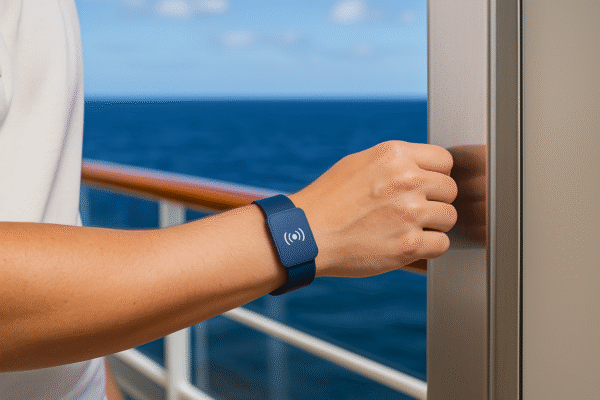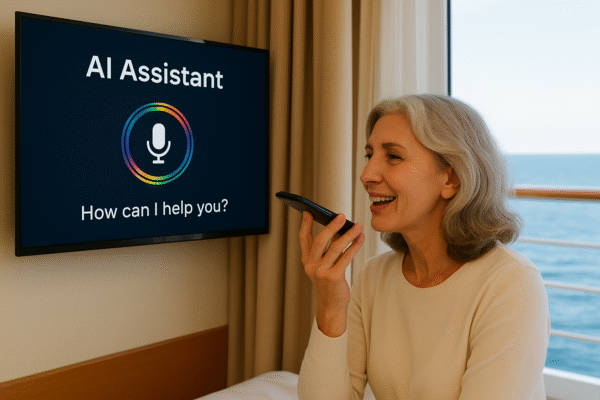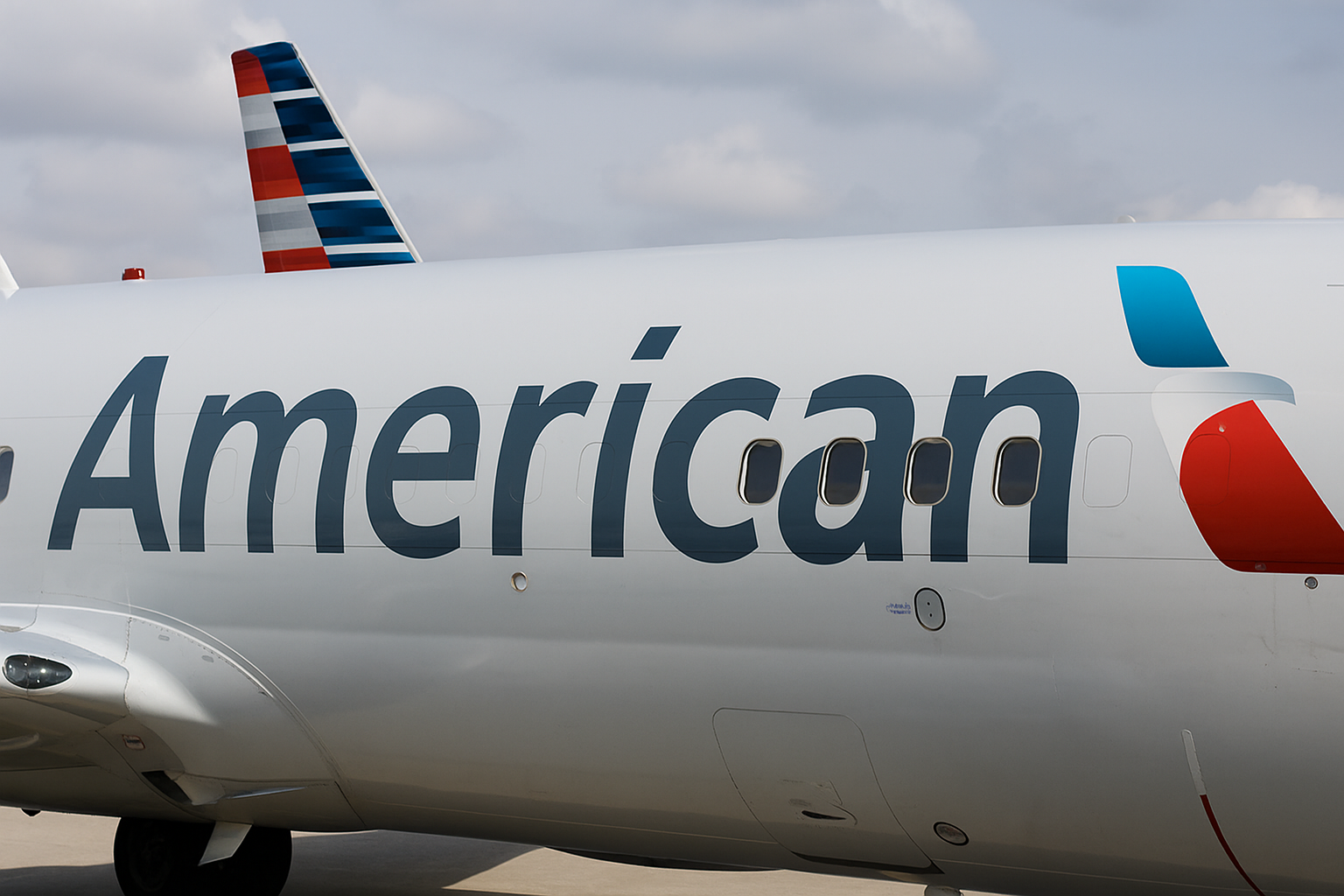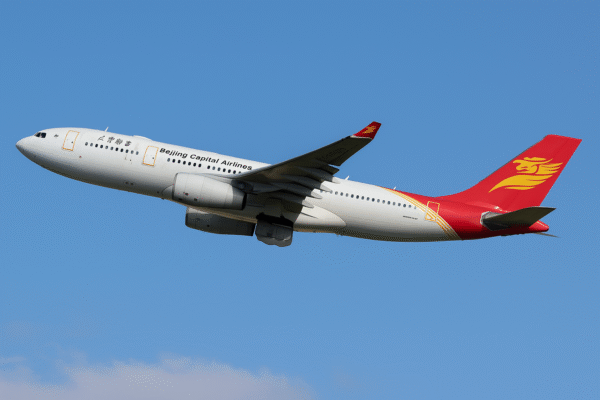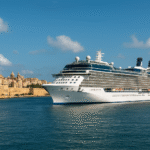The days of fumbling for a plastic keycard while boarding your cruise cabin or making a bar purchase may soon be behind us. Across the cruise industry, wearable wristbands equipped with RFID technology are transforming how guests access their rooms, make payments, and interact with onboard services.
Royal Caribbean, Disney Cruise Line, Virgin Voyages, Princess Cruises, and MSC Cruises are leading the charge, each introducing their own spin on smart wristbands that promise speed, convenience, and a more seamless passenger experience.
From Cabin Keys to All-Access Passes
These cruise wristbands do far more than open doors. They serve as all-in-one tools that replace multiple touchpoints during a voyage. With a simple tap, passengers can:
- Unlock their stateroom doors
- Make purchases at bars, restaurants, and onboard shops
- Check in and out of the ship at ports of call
- Access entertainment venues and dining reservations
- Track children or other family members onboard
For example, Royal Caribbean’s WOW Bands work as both a wearable bracelet and a SeaPass card. The newest version, the Adventure Ocean WOW Band, adds child-location tracking — a feature set to debut on August 31, 2025. Disney Cruise Line’s DisneyBand+ goes a step further by also functioning at Disney theme parks, while Virgin Voyages’ The Band offers a sustainable edge with its construction from recycled ocean plastic. Princess Cruises’ Medallion, available as a wristband or necklace, automatically unlocks cabin doors when guests approach, and MSC’s for Me wristband is waterproof, lightweight, and designed for comfort in all cruise activities.
Why Cruise Lines Love Wristbands
Convenience tops the list of benefits. No more fishing around in pockets or bags for a keycard — the wristband is always there, ready to use. On large ships where guests are constantly on the move, this translates to smoother, faster interactions across the board.
Security also gets a boost. Wristbands reduce the risk of losing a keycard and can be deactivated instantly if misplaced. In family scenarios, location tracking offers peace of mind, especially in sprawling mega-ships where children might explore independently.
Sustainability plays a role, too. Virgin Voyages has embraced eco-friendly materials, and as consumer demand for responsible travel grows, more cruise lines may follow suit.
The Drawbacks to Wearing Your Key
Despite their advantages, cruise wristbands aren’t without their downsides.
Privacy Concerns are chief among them. Location tracking, while useful for families, may make some passengers uneasy about constant monitoring. Questions about data storage, access, and usage remain ongoing topics of debate in the travel industry.
Style and Comfort can also be issues. Some guests prefer not to wear a visible accessory during their vacation, particularly during formal evenings. Wristbands may feel out of place with certain attire, and unlike keycards, they cannot simply be tucked away.
Cost varies widely. Some cruise lines include basic wristbands free of charge, while others charge for premium designs. DisneyBand+ designs can cost over $40, and Royal Caribbean’s WOW Bands often require a new purchase for each voyage, limiting reusability.
Will Wristbands Replace Keycards Entirely?
The growing adoption of wristbands suggests they could eventually phase out keycards, but that shift will require a balance between technology and passenger preference. For some travelers, the familiarity and discreet nature of a keycard remains appealing.
Cruise lines will also need to address technical limitations, such as ensuring wristband location tracking functions reliably both at sea and in port. Greater integration with onboard apps, expanded payment compatibility, and enhanced personalisation could tip the scales toward making wristbands standard issue in the next decade.
Given the cruise industry’s rapid embrace of contactless technology — accelerated in part by global health concerns and consumer demand for frictionless experiences — the transition appears more a question of “when” than “if.”
The Bigger Picture: A Connected Cruise Future
Wristbands are part of a broader trend toward personalisation and connectivity at sea. Future enhancements could see wearable tech integrated with AI-driven itineraries, biometric boarding, and even virtual reality shore excursions.
For cruise operators, this technology also delivers valuable data insights — from passenger movement patterns to spending habits — which can help tailor services, optimise operations, and improve onboard experiences.
Conclusion: A Sea Change in Cruise Travel
Wearable wristband technology is reshaping cruise travel by offering guests unprecedented convenience, security, and customisation. While they may not replace keycards overnight, their growing presence signals a clear shift toward a fully connected cruise experience.
As more passengers embrace the ease of tapping into their vacation — quite literally — the cruise industry edges closer to a future where your entire journey can be managed from your wrist. Whether you’re sailing through the Caribbean, exploring the Mediterranean, or crossing the Pacific, your next cruise might just be as simple as a single tap.
If you’d like, I can now create a textless 600×400 image showing a modern cruise wristband in use onboard a luxury ship — perfect to pair with this article. Would you like me to generate it?
Ask ChatGPT
The days of fumbling for a plastic keycard while boarding your cruise cabin or making a bar purchase may soon be behind us. Across the cruise industry, wearable wristbands equipped with RFID technology are transforming how guests access their rooms, make payments, and interact with onboard services.
Royal Caribbean, Disney Cruise Line, Virgin Voyages, Princess Cruises, and MSC Cruises are leading the charge, each introducing their own spin on smart wristbands that promise speed, convenience, and a more seamless passenger experience.
From Cabin Keys to All-Access Passes
These cruise wristbands do far more than open doors. They serve as all-in-one tools that replace multiple touchpoints during a voyage. With a simple tap, passengers can:
- Unlock their stateroom doors
- Make purchases at bars, restaurants, and onboard shops
- Check in and out of the ship at ports of call
- Access entertainment venues and dining reservations
- Track children or other family members onboard
For example, Royal Caribbean’s WOW Bands work as both a wearable bracelet and a SeaPass card. The newest version, the Adventure Ocean WOW Band, adds child-location tracking — a feature set to debut on August 31, 2025. Disney Cruise Line’s DisneyBand+ goes a step further by also functioning at Disney theme parks, while Virgin Voyages’ The Band offers a sustainable edge with its construction from recycled ocean plastic. Princess Cruises’ Medallion, available as a wristband or necklace, automatically unlocks cabin doors when guests approach, and MSC’s for Me wristband is waterproof, lightweight, and designed for comfort in all cruise activities.
Why Cruise Lines Love Wristbands
Convenience tops the list of benefits. No more fishing around in pockets or bags for a keycard — the wristband is always there, ready to use. On large ships where guests are constantly on the move, this translates to smoother, faster interactions across the board.
Security also gets a boost. Wristbands reduce the risk of losing a keycard and can be deactivated instantly if misplaced. In family scenarios, location tracking offers peace of mind, especially in sprawling mega-ships where children might explore independently.
Sustainability plays a role, too. Virgin Voyages has embraced eco-friendly materials, and as consumer demand for responsible travel grows, more cruise lines may follow suit.
The Drawbacks to Wearing Your Key
Despite their advantages, cruise wristbands aren’t without their downsides.
Privacy Concerns are chief among them. Location tracking, while useful for families, may make some passengers uneasy about constant monitoring. Questions about data storage, access, and usage remain ongoing topics of debate in the travel industry.
Style and Comfort can also be issues. Some guests prefer not to wear a visible accessory during their vacation, particularly during formal evenings. Wristbands may feel out of place with certain attire, and unlike keycards, they cannot simply be tucked away.
Cost varies widely. Some cruise lines include basic wristbands free of charge, while others charge for premium designs. DisneyBand+ designs can cost over $40, and Royal Caribbean’s WOW Bands often require a new purchase for each voyage, limiting reusability.
Will Wristbands Replace Keycards Entirely?
The growing adoption of wristbands suggests they could eventually phase out keycards, but that shift will require a balance between technology and passenger preference. For some travelers, the familiarity and discreet nature of a keycard remains appealing.
Cruise lines will also need to address technical limitations, such as ensuring wristband location tracking functions reliably both at sea and in port. Greater integration with onboard apps, expanded payment compatibility, and enhanced personalisation could tip the scales toward making wristbands standard issue in the next decade.
Given the cruise industry’s rapid embrace of contactless technology — accelerated in part by global health concerns and consumer demand for frictionless experiences — the transition appears more a question of “when” than “if.”
The Bigger Picture: A Connected Cruise Future
Wristbands are part of a broader trend toward personalisation and connectivity at sea. Future enhancements could see wearable tech integrated with AI-driven itineraries, biometric boarding, and even virtual reality shore excursions.
For cruise operators, this technology also delivers valuable data insights — from passenger movement patterns to spending habits — which can help tailor services, optimise operations, and improve onboard experiences.
Conclusion: A Sea Change in Cruise Travel
Wearable wristband technology is reshaping cruise travel by offering guests unprecedented convenience, security, and customisation. While they may not replace keycards overnight, their growing presence signals a clear shift toward a fully connected cruise experience.
As more passengers embrace the ease of tapping into their vacation — quite literally — the cruise industry edges closer to a future where your entire journey can be managed from your wrist. Whether you’re sailing through the Caribbean, exploring the Mediterranean, or crossing the Pacific, your next cruise might just be as simple as a single tap.
For more travel news like this, keep reading Global Travel Wire

